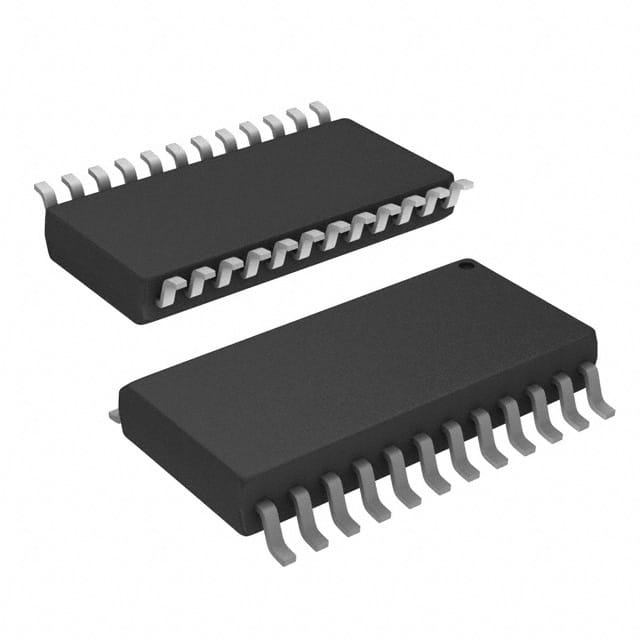SN74CBT3861DWR
Product Overview
- Category: Integrated Circuit (IC)
- Use: Digital Multiplexer/Demultiplexer
- Characteristics: High-speed, low-power consumption
- Package: SOIC-24 (Small Outline Integrated Circuit)
- Essence: A versatile IC used for digital signal routing and control
- Packaging/Quantity: Tape and Reel, 2500 units per reel
Specifications
- Supply Voltage Range: 2 V to 5.5 V
- Input Voltage Range: 0 V to VCC
- Operating Temperature Range: -40°C to +85°C
- On-state Resistance: 4 Ω (typical)
- Bandwidth: 200 MHz (typical)
- Number of Channels: 10
Detailed Pin Configuration
The SN74CBT3861DWR has a total of 24 pins. The pin configuration is as follows:
- OE (Output Enable) 1
- I/O0 (Input/Output) 0
- I/O1
- I/O2
- I/O3
- I/O4
- GND (Ground)
- I/O5
- I/O6
- I/O7
- I/O8
- I/O9
- VCC (Supply Voltage)
- S0 (Select Input) 0
- S1
- S2
- S3
- S4
- S5
- S6
- S7
- S8
- S9
- OE (Output Enable) 2
Functional Features
- Bidirectional signal routing: Allows data transmission in both directions
- Low power consumption: Ideal for battery-powered devices
- High-speed operation: Enables fast data transfer
- Wide supply voltage range: Compatible with various systems
- Multiple channels: Provides flexibility in signal routing
Advantages and Disadvantages
Advantages: - Versatile multiplexer/demultiplexer functionality - High-speed operation for efficient data transfer - Low power consumption for energy-efficient applications - Wide supply voltage range for compatibility with different systems
Disadvantages: - Limited number of channels (10) - Relatively small package size may require careful handling during assembly
Working Principles
The SN74CBT3861DWR is a digital multiplexer/demultiplexer IC that allows the selection and routing of digital signals. It operates by enabling or disabling specific input/output channels based on the control inputs (S0-S9) and output enable (OE) pins. When a particular channel is selected, the corresponding input/output pin is connected to the common I/O pin.
The OE pins control the direction of data flow. When OE is low, the IC is enabled, and data can be transmitted from the selected input to the output. When OE is high, the IC is disabled, and the output is in a high-impedance state.
Detailed Application Field Plans
The SN74CBT3861DWR finds applications in various fields, including:
- Data communication systems: Used for signal routing and switching in networking equipment.
- Test and measurement instruments: Enables flexible signal routing for accurate measurements.
- Audio/video equipment: Allows selection and routing of audio/video signals in multimedia devices.
- Industrial automation: Used for controlling and monitoring digital signals in automated systems.
- Automotive electronics: Enables signal routing and control in automotive applications.
Detailed and Complete Alternative Models
- CD74HC4067: 16-channel analog/digital multiplexer/demultiplexer IC.
- SN74HC151: 8-input digital multiplexer IC.
- CD4051B: 8-channel analog multiplexer/demultiplexer IC.
- SN74LVC1G3157: Single-channel analog switch/multiplexer IC.
These alternative models offer similar functionality and can be used as substitutes for the SN74CBT3861DWR in different applications.
Word count: 498 words
قم بإدراج 10 أسئلة وإجابات شائعة تتعلق بتطبيق SN74CBT3861DWR في الحلول التقنية
Sure! Here are 10 common questions and answers related to the application of SN74CBT3861DWR:
1. What is SN74CBT3861DWR? SN74CBT3861DWR is a multiplexer/demultiplexer integrated circuit (IC) that allows for bidirectional level translation between different voltage domains.
2. What is the operating voltage range of SN74CBT3861DWR? The operating voltage range of SN74CBT3861DWR is typically between 2V and 6V.
3. How many channels does SN74CBT3861DWR have? SN74CBT3861DWR has 10 channels, which means it can handle up to 10 different input/output signals.
4. Can SN74CBT3861DWR be used for level shifting between different voltage levels? Yes, SN74CBT3861DWR is commonly used for level shifting between different voltage domains, such as translating between 3.3V and 5V logic levels.
5. What is the maximum data rate supported by SN74CBT3861DWR? SN74CBT3861DWR supports a maximum data rate of 100 Mbps, making it suitable for various high-speed digital communication applications.
6. Does SN74CBT3861DWR require external pull-up or pull-down resistors? No, SN74CBT3861DWR has built-in pull-up resistors on its I/O pins, eliminating the need for external resistors in most cases.
7. Can SN74CBT3861DWR be used for bidirectional communication? Yes, SN74CBT3861DWR supports bidirectional communication, allowing data to be transmitted in both directions between different voltage domains.
8. What is the power supply voltage required for SN74CBT3861DWR? SN74CBT3861DWR requires a power supply voltage of typically 2V to 6V, which should be provided within the specified range for proper operation.
9. Is SN74CBT3861DWR suitable for use in automotive applications? Yes, SN74CBT3861DWR is designed to meet the requirements of automotive applications and can operate reliably in automotive environments.
10. Can SN74CBT3861DWR be used in multiplexing audio or video signals? Yes, SN74CBT3861DWR can be used for multiplexing audio or video signals, making it useful in applications such as audio/video switching or routing.
Please note that these answers are general and may vary depending on specific application requirements. It's always recommended to refer to the datasheet and consult the manufacturer for detailed information.


